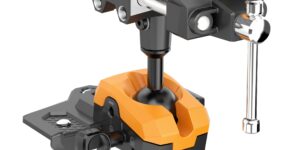AUTOMOTIVE COMPOSITE MATERIALS AND PROCESS TECHNOLOGY
This new technology from MAG Industrial Automation Systems can produce vehicle underbody components that are 40-60 percent lighter than steel but engineered for structural load requirements.
Posted: March 29, 2010
MAG Industrial Automation Systems (Hebron, KY) is introducing breakthrough automotive composites technology that merges the cost and production-rate requirements of the automotive industry with the engineered performance of oriented-fiber structures used in the aerospace industry.
The company's new Continuous Laminating Line for automotive components utilizes MAG's new continuous-fiber thermoplastic and thermoset prepregs to produce thin-walled, structurally engineered parts that meet OEM cost and volume targets. Aimed at vehicle architecture and underbody components, the resulting parts are 40-60 percent lighter than steel and twice as strong as high-strength SMC.
"This is game changing technology that bridges the gap between the requirements of the aerospace and automotive industries in terms of material costs, production rates and part-performance requirements," says Dan Allman, director of MAG's Automotive Composites Business Unit. "In aerospace, material costs are high, production rates low, and performance requirements extremely high, while the automotive industry requires low material costs, high production rates, and performance that meets or exceeds known solutions from the metals world.
"Our development target has been a continuous-fiber material cost that works within the automotive OEM's cost model," he continues. "From a processing standpoint, we've leveraged our aerospace experience in creating 100-percent oriented-fiber structures, and have now re-defined the application range with new materials and lay-up systems that can hit automotive cost and volume requirements."
According to Allman, new solutions for composite parts start with materials. "We've concentrated on optimizing the performance of low-cost reinforcements, such as E-glass, though carbon fiber and hybrid materials ? both thermoset and thermoplastic ? can be processed with our machinery," he explains. "The new continuous fiber prepregs we've developed have a much lower coefficient of variation than SMC, with a very uniform distribution and orientation of the reinforcement, compared to chopped fiber."
Prepregs allow very high concentrations of the reinforcing materials to be used: up to 70 percent by weight. Oriented-fiber composites, by nature, have significantly higher physical properties than random chopped-fiber materials. This laminating technology can take advantage of this by orienting the fiber to the axes of stress and load of the application. "We can tailor the reinforcement during lay-up to meet the engineering requirements of the part, whether it's a structural component or full multi-piece underbody," adds Allman.
MAG's material solutions are out-of-autoclave cured, and can be used with aluminum or nickel-shell tooling for low volumes, or steel tooling for high production volumes. Prepreg fiber orientation can be either unidirectional or multi-ply/multiaxial. The material exhibits excellent shape/drape forming characteristics. "From a quality standpoint, the variation of this material as an input to the manufacturing process is better than what's seen in aerospace, and significantly better than SMC. It also has good shelf-life at room temperature, with zero VOC or HAP issues," Allman emphasizes.
On the production side, Allman says the unanswered question for making oriented-fiber automotive parts has been a manufacturing solution ? that issue is now resolved with new technology from MAG R&D. This new Continuous Laminating Line for automotive components is based on a modular design for scalability. Each module can hold two rolls of material up to 80 in (2.4 m) wide or smaller. In-line cutting and splicing allows continuous operation, as well as placement of cross plies to reinforce transitional areas, such as cross-car stiffeners on a floorpan.
Modules for placement of core materials to produce sandwich structures are also being developed, because sandwich structures provide the highest stiffness-to-weight performance. One of the many unique features of this system, says Allman, is the ability to lay up various widths in a single part. Module one can process a full-width material, then module two can process a narrower material to reinforce a transmission tunnel, for example. Exiting the lay-up modules, the material can be cut to net shape via an in line cutting system, if the process or application requires it.
Allman explains how current design/FEA engineering software can model and predict the behavior of components produced with this technology, and all it will take is a "design for composites" mentality to reverse the decline of composites in the automotive industry. "The de-weighting required to meet the new fuel economy standards has renewed interest in composites," he notes. ?The industry is hitting the limits of de-weighting with alternative materials such as aluminum and cast magnesium.?
Working with OEM's outside North America, MAG's material and manufacturing technologies are enabling composites-intensive vehicle architecture, including the front/rear firewalls, floorpan, rear tub and other components, as current examples he cites. ?The two success drivers are high performance/low cost materials and the manufacturing solution to support any platform's annual build volumes. Many metal parts can be replaced with composites, and if properly designed, the car will equal or outperform conventional construction in NVH and crash worthiness," he states.
MAG is a leading machine tool and systems company serving the durable-goods industry worldwide with complete manufacturing solutions. The company offers a comprehensive line of equipment and technologies including process development, automated assembly, turning, milling, automotive powertrain production, composites processing, maintenance, automation and controls, and core components. Key industrial markets served by these technologies include aerospace, automotive and truck, heavy equipment, oil and gas, rail, solar energy, wind turbine production and general machining.
With manufacturing and support operations strategically located worldwide, MAG ranks as a leader in the capital equipment market. A growing number of leading international companies are relying on the impressive innovation power of MAG to assure their technological leadership and prepare for future challenges.
———————————————————————————
MAG Industrial Automation Systems, 859-534-4537, www.mag-ias.com, e-mail: Bridget Spears, bridget.spears@mag-ias.com.









